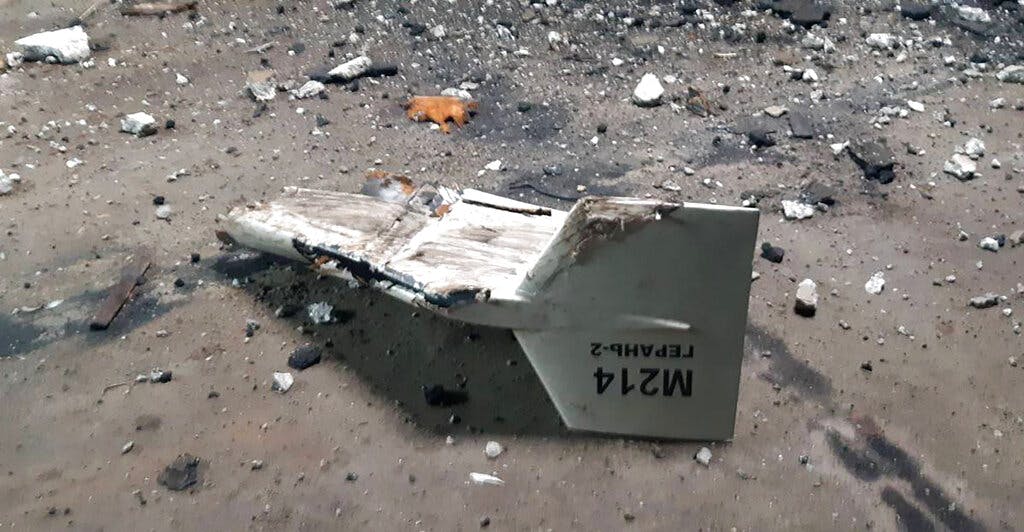Iranian Drones in Spotlight After Israeli-Owned Oil Tanker Attacked
The Islamic Republic has perfected the manufacturing of UAVs as part of its increasingly aggressive wars in the Mideast and beyond.

The hit on an Israeli-owned oil tanker traveling off the Omani coast Wednesday amplifies the growing danger of Iran’s kamikaze drones being used in various war theaters, including, most recently, Ukraine.
Israeli officials say the explosive drone attack was aimed at disrupting the World Cup soccer tournament, scheduled to begin in Qatar Sunday. Most likely, however, it is part of an ongoing shadow war between Israel and the Islamic Republic, in which Iran is eager to retaliate for attacks on its advanced weapons and nuclear facilities.
The 600-foot tanker, the Pacific Zircon, is owned by the Singapore-based Eastern Pacific Shipping company, founded by an Israeli billionaire, Idan Ofer. While the vessel’s aft caught fire and the hull suffered minor damage, there was “no spillage of cargo or water ingress,” according to a company statement. The crew was unharmed.
Israeli and American officials blamed Iran for the drone attack. “This Unmanned Aerial Vehicle attack against a civilian vessel in this critical maritime strait demonstrates, once again, the destabilizing nature of Iran’s malign activity in the region,” the leader of the U.S. Central Command, General Michael Kurilla, told the U.S. Naval Institution.
An Israeli official said the vessel was hit by an Iranian “kamikaze” drone, Shahed 136 — the same type of UAV that Iran is selling to Russia for use in Ukraine, in violation of a United Nations Security Council resolution. Today the American treasury department announced new sanctions against “firms involved in the production or ongoing transfer to Russia of Iranian” UAVs.
The Shahed 136, a remote-controlled craft that homes in and then explodes on a target, has become a top weapon for Russia in its attacks against Ukrainian military targets and civilian infrastructure. With a price tag of about $20,000 per unit, these drones are much cheaper than Russian-made missiles, and are nearly as accurate.
The Islamic Republic has perfected the manufacturing of such UAVs as part of its increasingly aggressive wars in the Mideast and beyond. First crudely used as far back as the 1980s Iran-Iraq war, Tehran in recent years has equipped its regional proxies with drones to attack Iran’s enemies.
The Yemeni Houthis have employed attack drones against Saudi and United Arab Emirates targets, while Hezbollah and Hamas use them against Israel. In addition to such proxies, the Iranians have built factories in far away places in order to reduce targeting by Israel and other enemies.
One of the first such drone production lines outside of Iran is in Tajikistan, one base for Tehran’s growing presence in Central Asia. More worrisome for America is the ever-deepening ties between the Islamic State and Venezuela. The two countries have recently signed a 20-year cooperation pact that guarantees supply of Iranian arms to Caracas, including attack drones that can reach American soil.
Last month the London-based Syrian Observatory for Human Rights reported that Israel demolished a Hezbollah-operated Iranian drone assembly site near the Damascus, Syria, airport. The attack, which rocked the Syrian capital, was part of a long war Israel has conducted against various assets of the Iranian Quds Force of the Islamic Revolutionary Guards Corps.
“This is the most significant war Israel has fought since the 1973 Yom Kippur war, and no one is talking about it,” the Foundation for Defense of Democracies’ vice president, Jonathan Shcanzer, says. “It’s the war between wars that started under Netanyahu, continued under Bennett and Lapid, and will now go on under Bibi again,” Mr. Schanzer told the Sun, referring to the three most recent Israeli prime ministers.
As part of that war, Israel in recent years has hit IRGC targets in Syria, Lebanon, and Iran itself. There, it has reportedly assassinated top Tehran military officials and nuclear scientists, and is widely suspected — at times wrongly — of causing mysterious fires and explosions in or near sensitive drone, missile, and nuclear facilities.
Tehran, meanwhile, is hard at work trying to hit Israeli targets. Yesterday Tbilisi officials announced that with the help of Israeli security forces, it foiled an attempt to assassinate an Israeli businessman, Itzik Moshe, who lives in Israel and Georgia. A Pakistani team was hired to kill Mr. Moshe, and it was aided by Quds operatives who have supplied the weapons and logistics. Today’s attack on the Pacific Zircon was another Iranian attempt on Israeli targets.
Iran at times succeeds, but “Israel is winning in nine out of ten cases,” Mr. Schanzer says. While the Iranians merely aim at any vulnerable Israeli target they can hit, Israel is striking at Iranian strategic assets, including the drone industry that poses an “increased threat to international security,” Mr. Schanzer adds.
Israel has long understood that threat to the Gulf’s Iranian enemies, to Central Europe, as well as to America, via Venezuela. It took the Ukraine war to get America fully involved in reducing that menace. Washington now needs to go beyond targeted sanctions against Ukraine war-related Iranian assets.

